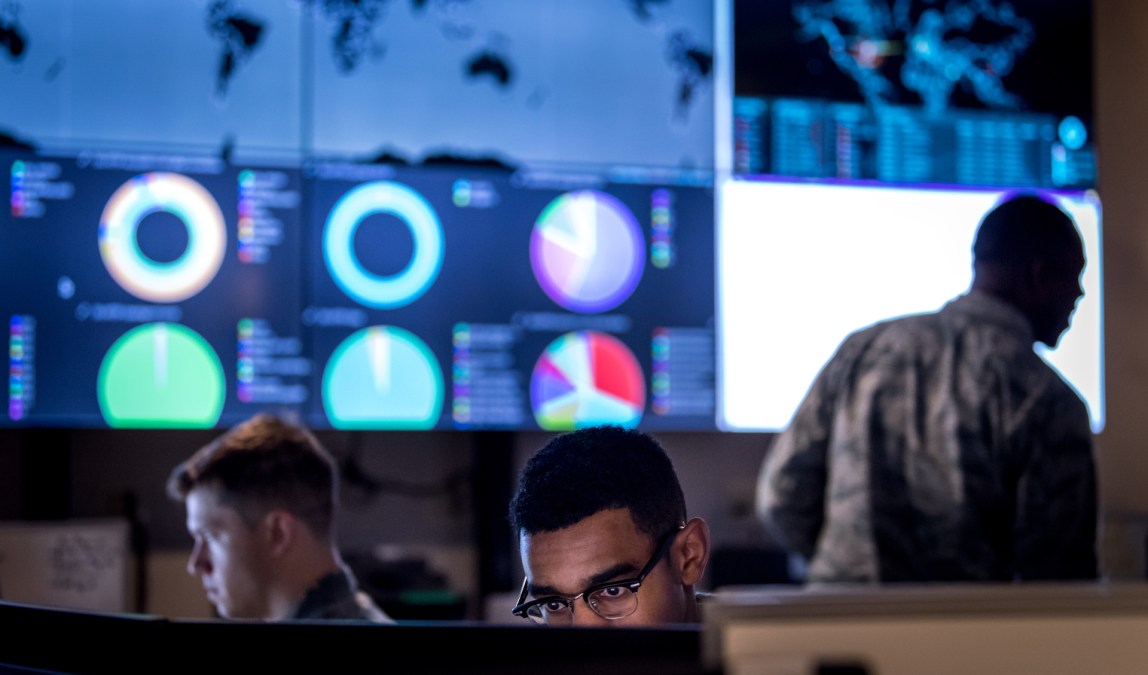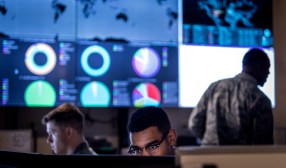Air Force outgoing commander says department’s information warfare command must scale

The key to maintaining initial successes in the vision of the Air Force’s first information warfare command in reducing stovepipes and achieving outcomes is being able to scale in the future, its outgoing commander said.
Regarding what’s next for 16th Air Force, “much of it has to do with our ability to scale and to meet the just ever increasing demand for what our airmen bring as they generate insights, as they produce outcomes every day as part of various campaigns, but also how they are preparing for operations against our pacing threat,” Lt. Gen. Timothy Haugh, told reporters ahead of the July 21 change of command ceremony. “That ability to scale to meet that diversity is that really the long term challenge for 16th Air Force, while the team has realized over the last three years that initial task to be able to integrate these capabilities.”
Haugh heads to U.S. Cyber Command to serve as its deputy commander while Lt. Gen. (Sel) Kevin Kennedy will take the reins of 16th Air Force, which serves as the service component for Cyber Command and NSA.
The vision for creating 16th Air Force in 2019 was breaking down the silos that existed between cyber, intelligence, surveillance and reconnaissance, electromagnetic spectrum operations and information operations by converging them to better serve combatant commander needs.
“They’ll go to war with the Air Force built by chief 21 … Today’s ceremony is a significant contribution to this moral obligation; ensuring we continue to fly, fight and win in air, space and cyberspace, now and into the future,” then-Gen. David Goldfein, the 21st chief of staff of the Air Force said at the 16th Air Force activation ceremony in 2019 regarding his vision for the command. “By combining the disciplines of cyber operations, ISR, electronic warfare, information operations, under a single command, we’ll remove walls and stovepipes.”
Haugh, as its first commander, said he’s proud of the progress the team has made in delivering outcomes for mission partners and creating the synergies and convergence. They need to continue to build upon these frameworks and scale in order to maintain that convergence to beat back adversaries in an ever dynamic information warfare environment.
One such area includes tightening the convergence of cyber and electromagnetic spectrum operations.
“That is an area where our service is talking about it, it’s an area Congress is interested in and now we think we can inform some of that based off of the expertise we have within our various wings,” Haugh said. “What we really want to capitalize on is the talent that brings unique expertise. That’s part of the magic of bringing 16th Air Force together is the Air Force set out and said that one of the things that we will invest in is how do we more effectively use the electromagnetic spectrum.”
The Air Force has created a combined detachment between the 55th Wing and the 67th Cyberspace Wing.
“We’re at the point now that we’ve allowed them to come together as part of our weapons and tactics conferences to see what are the things that we should be investing in that would allow them to collaborate and to produce outcomes,” Haugh said. “We have established a combined detachment between the two wings to allow them to bring that expertise together. I’m excited. We’ll see where they take that in the future, but we see based off of how cyber continues to have increasing reliance on the spectrum and then where are our adversaries go, we wanted to make sure that we’re bringing together the right expertise to innovate as that dynamic changes.”
Another area Haugh said they’re looking to scale is information operations planning.
“The growth of IO planning and the necessary role that information plays as a joint function inside the Department of Defense, that conversation of what is the role of units as components, what’s the role of our service, how do we support the combatant commands we’re aligned with, all of that does take additional capacity to ensure that we’re aligned with what it looks like in the information environment for those various commanders,” he said.
In the last two years, the Air Force has created the first initial skills training course for its information operations personnel, 14F. While this force is small, plans are to grow it to around 500 in the future.
How the services grows the capacity across all its disciplines at the right level is a balancing act, Haugh said, and they’re partnering with Air Combat Command and the combatant commands to make sure they get it right as 16th Air Force has been developing new tactics as it matures.
Partnerships
One of the areas Haugh said he underestimated upon leading this new organization was the opportunities for partnerships across the military, federal government and international sphere.
“What we found as a component to EUCOM, that when we talked with Naval Forces Europe, or U.S. Army Europe, or U.S. Air Forces Europe or an element of NATO, they all were really fast to say we see what capabilities you provide, how can we enable your outcomes, how can you partner with us,” he said. “The other element of partnership is our international partnerships and whether that’s helping a nation grow capacity or to partner with another nation, others to very large willingness encouraged by U.S. Cyber Command for us to partner with any number of nations that are trying to grow cyber capacity or share interests with the outcomes we’re trying to achieve.”
Part of this partnership with other combatant commands stem from the growth and maturity of what’s know as Cyber Operations-Integrated Planning Elements.
16th Air Force, as the service component to Cyber Command, provides cyber forces and support to European Command, Strategic Command, Transportation Command and Space Command. This is done through a construct known as Joint Force Headquarters-Cyber (JFHQ-C), which provides planning, targeting, intelligence and cyber capabilities to the combatant commands to which they’re assigned. The heads of the four service cyber components also lead their respective JFHQ-Cs and oversee the cyber teams that conduct operations for the combatant commands.
The Cyber Operations-Integrated Planning Elements act as an extension of the JFHQ-Cs where cyber planners, not actual operators, are physically embedded within various staff sections at the combatant commands to provide expertise on how cyber can be incorporated into their operations.
“The ability for us to be a component in San Antonio connected simultaneously to European Command, Strategic Command, Space Command and providing a CO-IPE to TRANSCOM, without that team integrated in that combatant command staff, it would be very challenging to make sure that we’re meeting their demands,” Haugh said. “The maturity of the CO-IPEs as an element that can do cyberspace planning, intelligence development and targeting has been just absolutely essential to the maturation of Cyber Command and of the components, 16th Air Force included.”
Across the federal government, Haugh discussed the work done with the Department of Homeland Security and the FBI in sharing information to protect elections from foreign interference.
“As we look at the core mission of 16th Air Force, it’s a straightforward role that we have, which is to stop foreign interference in our electoral process. We’re proud to be on that team with all of our interagency partners for the role that our airmen play,” he said. “It also is exciting when you see the work that is going for alignment across how we’re approaching it, from the national cyber director to CISA to the FBI foreign influence task force, the role that NSA and Cyber Command play with the Department of Justice and then we’re contributing to that broader team. It’s powerful.”
Following the Russian operations in the 2020 election, which saw how adept they were in information warfare and how difficult those operations were to thwart, Haugh and his team have lauded the approach of exposing adversary activity to disrupt their operations in the information environment.
In the past, this has been done through the posting of malware samples to the public resource VirusTotal. Malware samples discovered in the course of operations by the Cyber National Mission Force are posted to the site to inform network owners. It also helps antivirus organizations of the strains build patches against that code and helps identify the enemies’ tools being used in ongoing campaigns.
Officials also have noted, in hypothetical examples, how various elements across the cyber and ISR realm, which now all exist under a single command creating a faster and more streamlined unity of effort, could work together to disclose the location of enemy missile batteries in the lead up to destructive action.
“It’s been successful. The ability to expose adversaries in a way that allows others to also become aware of that is a powerful concept,” Haugh said. “That exposure in and of itself isn’t something that that produces an outcome that deters an adversary, but it does impose costs. Those things are areas that we believe have to be part of any campaign, which is to expose the adversary and ensure that as we push things into the information environment, the Department of Defense operates in truth.”




